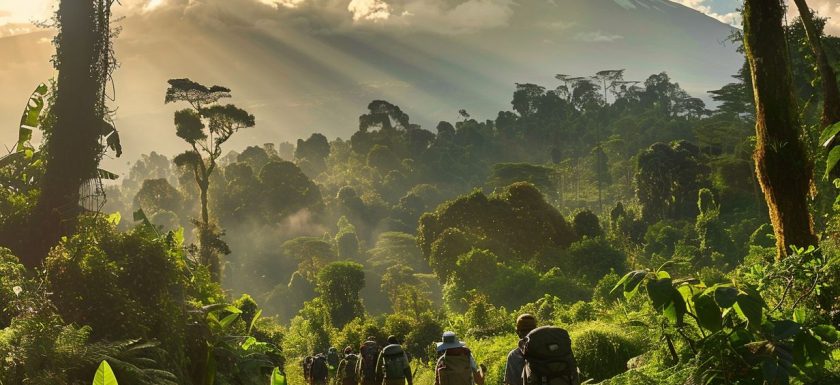
Are you considering hiking Kilimanjaro and wondering which route to choose?
The Marangu Route is a unique option with its own set of features that set it apart from the other trails. From the convenience of huts along the way to its reputation as the “Coca-Cola” route, there are many aspects to consider.
In this article, we will delve into the highlights, difficulty level, best time to hike, gear needed, itinerary, and health considerations of the Marangu Route. Find out if this route is the right fit for your Kilimanjaro adventure!
Key Takeaways:
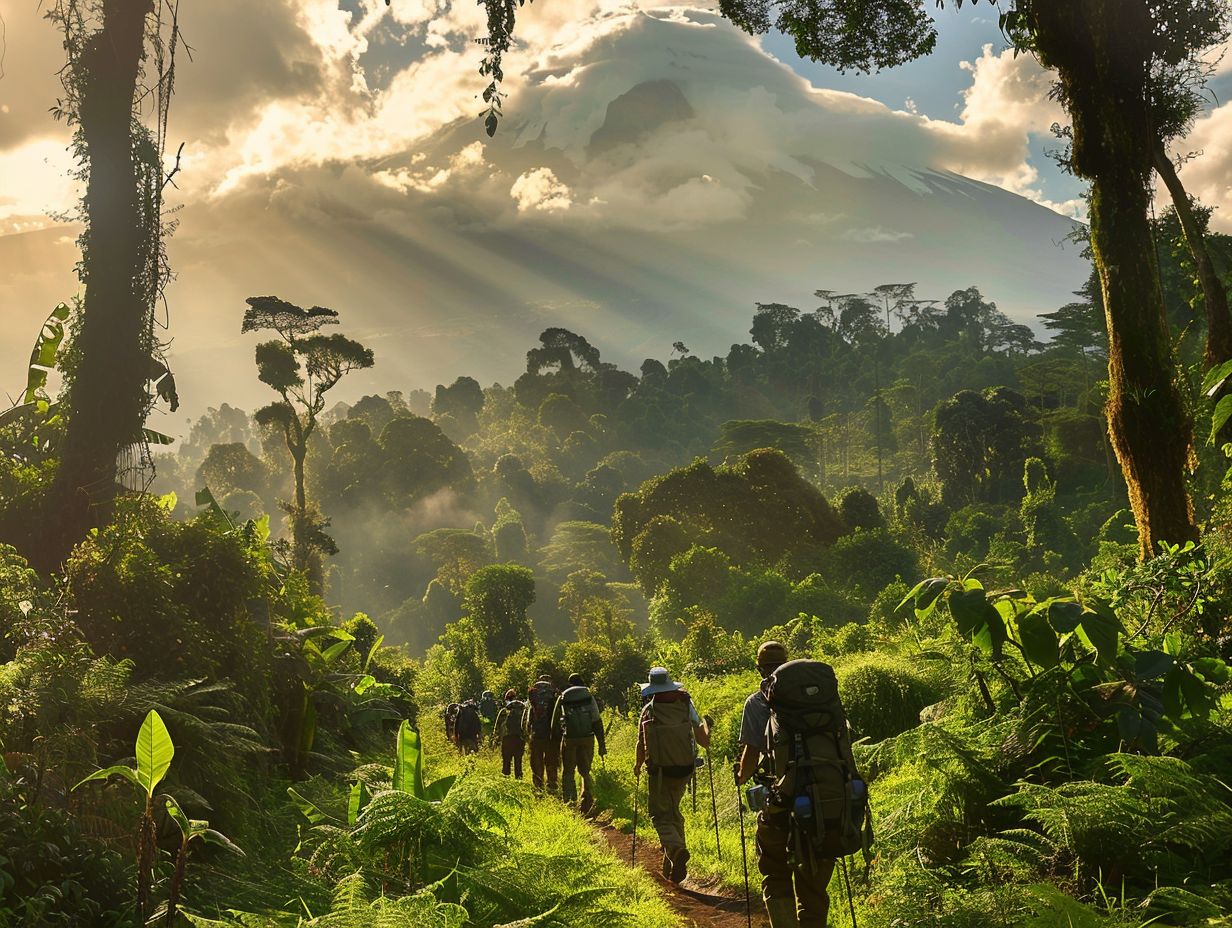
- The Marangu Route is the only route on Mount Kilimanjaro that offers huts for accommodation, making it a popular choice for those seeking a more comfortable trek.
- Considered the easiest route, the Marangu Route has a gradual ascent and moderate difficulty level, making it suitable for novice hikers.
- The best time to hike the Marangu Route is during the dry season from July to October, when the weather is more stable and the views are clear.
What Makes the Marangu Route Unique?
The Marangu Route stands out as a unique experience for climbers tackling the majestic Kilimanjaro. This route is renowned for its traditional huts that provide shelter and comfort during the ascent, making it distinct from other routes.
Originating in the 1920s, the Marangu Route boasts a rich historical significance as the oldest Kilimanjaro climbing route. The distinctive A-frame huts dotted along the trail were initially built to accommodate weary climbers and offer a sense of warmth and community in the midst of the challenging terrain.
These huts not only provide a cozy place to rest but also add to the heritage and charm of the route. The picturesque landscape, with lush forests giving way to alpine meadows, captivates climbers as they navigate through varying ecosystems.
The Only Route with Huts
The Marangu Route is distinguished as the sole route on Kilimanjaro equipped with comfortable huts for trekkers to rest and recuperate during the climb. These huts, such as Horombo Hut and Kibo Hut, offer a unique accommodation experience amidst the mountain’s challenging terrain.
Horombo Hut, located at an elevation of 3,720 meters, acts as a crucial acclimatization spot for climbers. It boasts cozy sleeping quarters, dining facilities, and bathroom amenities, providing a welcome respite after a day of trekking. Trekkers can savor warm meals here while enjoying stunning views of the surrounding landscape.
Kibo Hut, situated at an impressive altitude of 4,703 meters, serves as the final overnight stop before the summit push. Its basic yet functional accommodations include bunk beds, shared toilets, and a dining area offering nourishing meals to fuel climbers for the challenging ascent. These huts play a vital role in ensuring climbers’ safety, comfort, and readiness for the rigorous climb ahead.
Known as the “Coca-Cola” Route
The Marangu Route is affectionately referred to as the ‘Coca-Cola‘ route due to its popularity and relatively milder nature compared to other challenging routes on Kilimanjaro. This moniker reflects the route’s accessibility and appeal to a wide range of climbers.
This route holds a special place in the history of Kilimanjaro climbing, as it was one of the first established routes up the mountain, dating back to the early 1900s. Over the years, it has garnered a reputation for being the ‘touristy’ route, attracting a large number of climbers looking for a more comfortable and less strenuous ascent.
While some avid climbers may shy away from its well-trodden path, the ‘Coca-Cola’ route remains a popular choice for those seeking a relatively smoother climb.
Shortest Route in Terms of Distance
Among the various routes up Kilimanjaro, the Marangu Route stands out as the shortest in terms of distance, offering a more direct path to the summit.
This shorter distance presents both advantages and challenges for climbers seeking a quicker ascent. A shorter distance means less time spent on the trek, which can be beneficial for those looking for a faster summit attempt.
The reduced trekking distance also has implications for acclimatization. With less time spent ascending gradually, climbers may struggle with altitude sickness due to the quicker ascent. This could impact their overall success rates and the intensity of the journey, as the body may not have enough time to adjust to the altitude.
Thus, while the shorter distance may offer a faster route to the summit, climbers must be aware of the potential risks associated with the quick ascent.”
What is the Difficulty Level of the Marangu Route?
Considering the overall difficulty level, the Marangu Route falls into the category of moderate climbs, offering a manageable ascent for trekkers. The gradual terrain and established paths contribute to a more accessible trekking experience compared to other routes on Kilimanjaro.
Despite the moderate rating, climbers on the Marangu Route still face significant challenges, making it crucial to be well-prepared.
One of the key obstacles is the altitude variations encountered along the way. As trekkers ascend, the changing altitude can lead to symptoms of altitude sickness, such as headaches and fatigue. Proper acclimatization and hydration are essential to mitigate these effects.
Along with altitude, the physical demands of trekking also play a role in the route’s difficulty. The continuous uphill sections require endurance and strength, testing the limits of even experienced hikers. Proper fitness training beforehand can help climbers cope with the demands of the ascent.
Moderate Difficulty
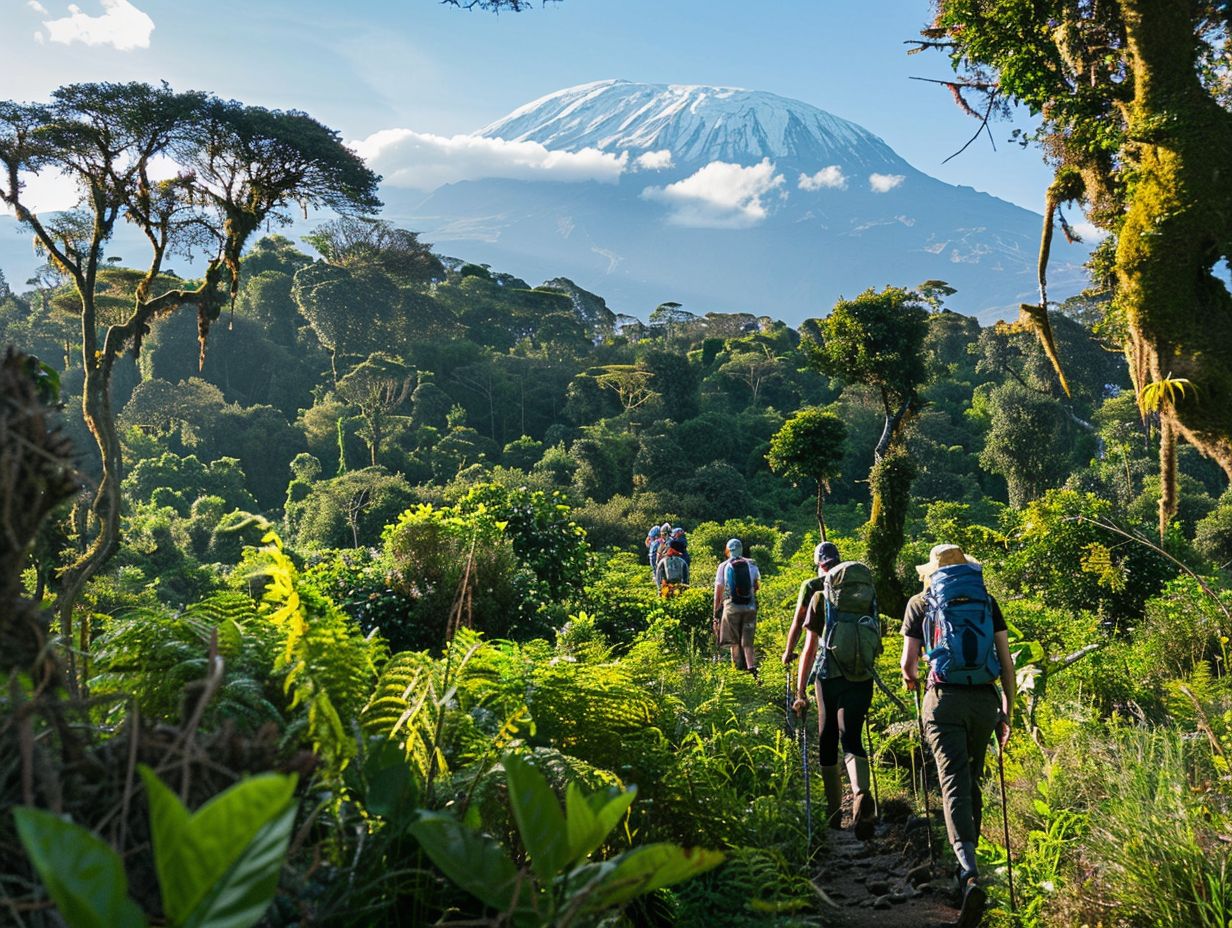
The Marangu Route is renowned for its moderate difficulty level, striking a balance between achievable climbs and challenging terrains. This accessibility makes it a popular choice for climbers looking for a less strenuous but equally rewarding Kilimanjaro experience.
One of the key sections along the Marangu Route that contributes to its moderate difficulty is the steep sections known as ‘The Wall’. This part requires climbers to navigate through a series of rocky steps, testing their endurance and agility.
The transition from the moorland to alpine desert zones can be physically demanding due to the changing terrain and altitude. Weather conditions, including sudden temperature drops and high winds, add another layer of challenge, requiring climbers to be well-prepared with appropriate gear. The narrow trails and occasional scree slopes also demand focus and careful footing, especially when fatigue sets in.
Gradual Ascent
A key feature of the Marangu Route is its gradual ascent profile, allowing climbers to acclimatize more effectively to increasing altitudes. This slower climb pace contributes to a higher success rate among trekkers aiming to reach the summit.
This gentle progression in altitude is beneficial as it gives the body adequate time to adjust to changing oxygen levels, reducing the risk of altitude-related illnesses like altitude sickness or pulmonary edema.
By allowing for rest intervals at various points along the route, climbers can recover and replenish their energy, thus improving their overall performance and endurance during the ascent. The gradual inclines help in minimizing the strain on muscles and joints, making the trek more manageable and enjoyable for adventurers of varying fitness levels.
What is the Best Time to Hike the Marangu Route?
To optimize your climbing experience on the Marangu Route, it is crucial to select the best time for your trek. The ideal period for hiking this route typically coincides with the dry seasons in the region, ensuring favorable weather conditions and clearer visibility for climbers.
During these drier months, which usually fall between late June and October and January to early March, you can expect lower chances of rainfall, which significantly reduces the risks of slippery and muddy trails.
The lower humidity levels and pleasant temperatures make the ascent less physically demanding and more enjoyable for trekkers. Opting for these months means encountering fewer crowds along the path, allowing you to immerse yourself fully in the natural beauty of the surroundings and enhancing your overall experience.
What are the Highlights of the Marangu Route?
Embarking on the Marangu Route offers a plethora of highlights that enrich the climbing experience. From breathtaking views of Kilimanjaro’s summit to traversing diverse climatic zones, each stage of the journey presents unique moments and challenges for trekkers.
Upon setting foot on the Marangu Route, climbers are immediately greeted with the lush rainforest that blankets the lower slopes, creating a serene and almost mystical atmosphere. Traversing through this verdant canopy, trekkers might catch glimpses of curious monkeys darting through the trees.
As the ascent continues, the landscape transitions into moorland, characterized by rolling hills adorned with vibrant heather and wildflowers, offering a striking contrast to the dense forest below. These sweeping vistas serve as a visual feast, rejuvenating climbers’ spirits with every step.
Scenic Views of Kilimanjaro
One of the notable highlights of the Marangu Route is the awe-inspiring panoramic views of Kilimanjaro’s majestic peaks, including the iconic Mawenzi Ridge. Trekkers are treated to stunning vistas that showcase the natural grandeur of this renowned mountain.
As climbers ascend along the Marangu Route, they are rewarded with breathtaking sights that transcend mere words. The vantage points offer a visual symphony of rugged terrain, sprawling glaciers, and dramatic slopes that seem to touch the sky.
Standing at the foot of Mawenzi Ridge, trekkers witness a surreal display of nature’s magnificence, with the jagged peaks cutting through the clouds like ancient sentinels. These views not only captivate the eyes but also inspire a profound sense of insignificance in the face of such monumental beauty.
Passing Through Different Climatic Zones
An intriguing aspect of the Marangu Route is the journey through distinct climatic zones as trekkers ascend Kilimanjaro. From lush rainforest regions to alpine deserts, climbers experience diverse ecosystems and weather patterns along the route.
As the trek begins, adventurers find themselves immersed in the dense, vibrant rainforests that thrive in the lower altitudes of Kilimanjaro.
Towering trees draped in moss create a magical canopy above, sheltering a variety of endemic plant species and playful monkeys swinging from branch to branch. The air is thick with moisture, and the symphony of exotic bird calls fills the air.
Ascending further, the landscape transitions into the heath and moorland zone, characterized by open expanses dotted with unique flora such as the iconic Lobelia glaberrima. This zone imparts a sense of vastness and isolation, as trekkers traverse rolling hills and grassy meadows, with glimpses of distant peaks in the hazy horizon.
Summiting Uhuru Peak
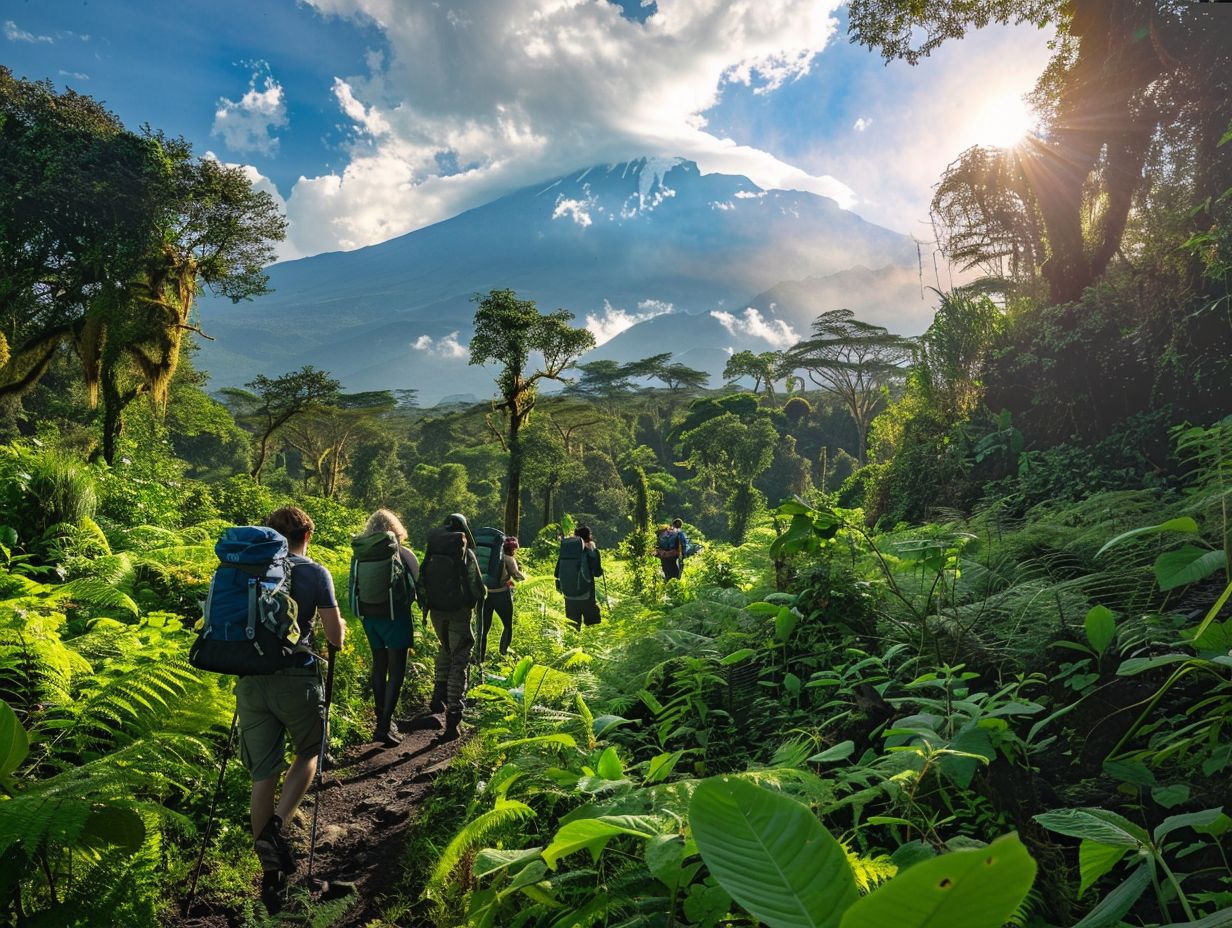
The ultimate highlight of the Marangu Route is reaching the summit of Kilimanjaro at Uhuru Peak, the highest point in Africa. Standing atop this iconic peak is a momentous achievement for climbers, symbolizing their perseverance and determination throughout the trek.
Upon reaching Uhuru Peak, climbers are enveloped by a whirlwind of emotions. The air is crisp, the sun’s rays illuminate the breathtaking landscape, and the feeling of accomplishment pervades the senses.
The panoramic view from the summit unveils a mesmerizing tapestry of clouds, glaciers, and vast African plains below, a sight reserved only for those who dare to brave the climb. Each step taken to ascend to this lofty height represents a triumph over both physical challenges and personal boundaries.
What Gear and Equipment Do You Need for the Marangu Route?
Preparing for the Marangu Route necessitates careful consideration of essential gear and equipment to ensure a safe and comfortable trekking experience. From sturdy hiking boots to insulated clothing, having the right gear can significantly impact your journey’s success and enjoyment.
- Clothing Layers: Pack moisture-wicking base layers, comfortable mid-layers, and a waterproof and windproof outer shell to cater to changing weather conditions.
- Footwear: Opt for high-quality, broken-in hiking boots with good ankle support to tackle the rugged terrain.
- Backpack: Choose a well-fitted, sturdy backpack with a capacity to carry essentials like water, snacks, and extra layers comfortably.
- Hydration Systems: Stay hydrated with a reliable hydration system such as a hydration bladder or water bottles.
- Other Specialized Gear: Consider carrying trekking poles for stability, a headlamp for night hikes, and a first aid kit for emergencies.
What is the Typical Itinerary for the Marangu Route?
The standard itinerary for the Marangu Route spans several days, guiding climbers through key waypoints such as Horombo Hut and Kibo Hut en route to the summit of Kilimanjaro. This structured plan ensures proper acclimatization and pacing for a successful ascent.
Upon embarking on this adventure, the first day typically involves looking into the lush rainforest surroundings as climbers make their way to the Mandara Hut. It serves as a perfect introduction to the trekking experience, covering a relatively shorter distance to aid in initial acclimatization.
The following day sees a gradual ascent to Horombo Hut, offering stunning views and providing a crucial rest stop for acclimatizing to the increasing altitude. This strategic acclimatization process helps minimize the risks of altitude sickness, ensuring climbers are prepared for the challenges ahead.
What are the Health and Safety Considerations for the Marangu Route?
Prioritizing health and safety is paramount when embarking on the Marangu Route ascent, given the altitude challenges and physical exertion involved in climbing Kilimanjaro. Understanding the risks, acclimatization strategies, and emergency protocols is essential for a smooth and secure trekking experience.
One of the key aspects to consider while tackling the altitude on the Marangu Route is to stay hydrated. Dehydration can exacerbate symptoms of altitude sickness and impact overall performance. It is advisable to carry an adequate supply of water and use electrolyte supplements to maintain your body’s fluid balance.
Along with proper hydration, having a well-equipped first aid kit is crucial. Include essentials like blister pads, pain relievers, bandages, and any personal medications. Familiarize yourself with basic first aid procedures before the climb.
Conclusion: Is the Marangu Route Right for You?
Deciding whether the Marangu Route is the ideal choice for their Kilimanjaro adventure depends on various factors, including their fitness level, trekking preferences, and summit aspirations. While this route offers unique advantages such as hut accommodations and predictable schedules, assessing its alignment with their goals and expectations is crucial for a fulfilling climb.
One of the key considerations when opting for the Marangu Route is its popularity among climbers due to the relative comfort of hut accommodations that provide shelter from the elements, particularly beneficial for those who prefer a bit more comfort during their trek.
It’s essential to note that this popularity can also mean more crowds along the trail, potentially affecting the overall experience, pace, and solitude that some climbers seek on their journey.
Frequently Asked Questions
What is the Marangu Route on Kilimanjaro?
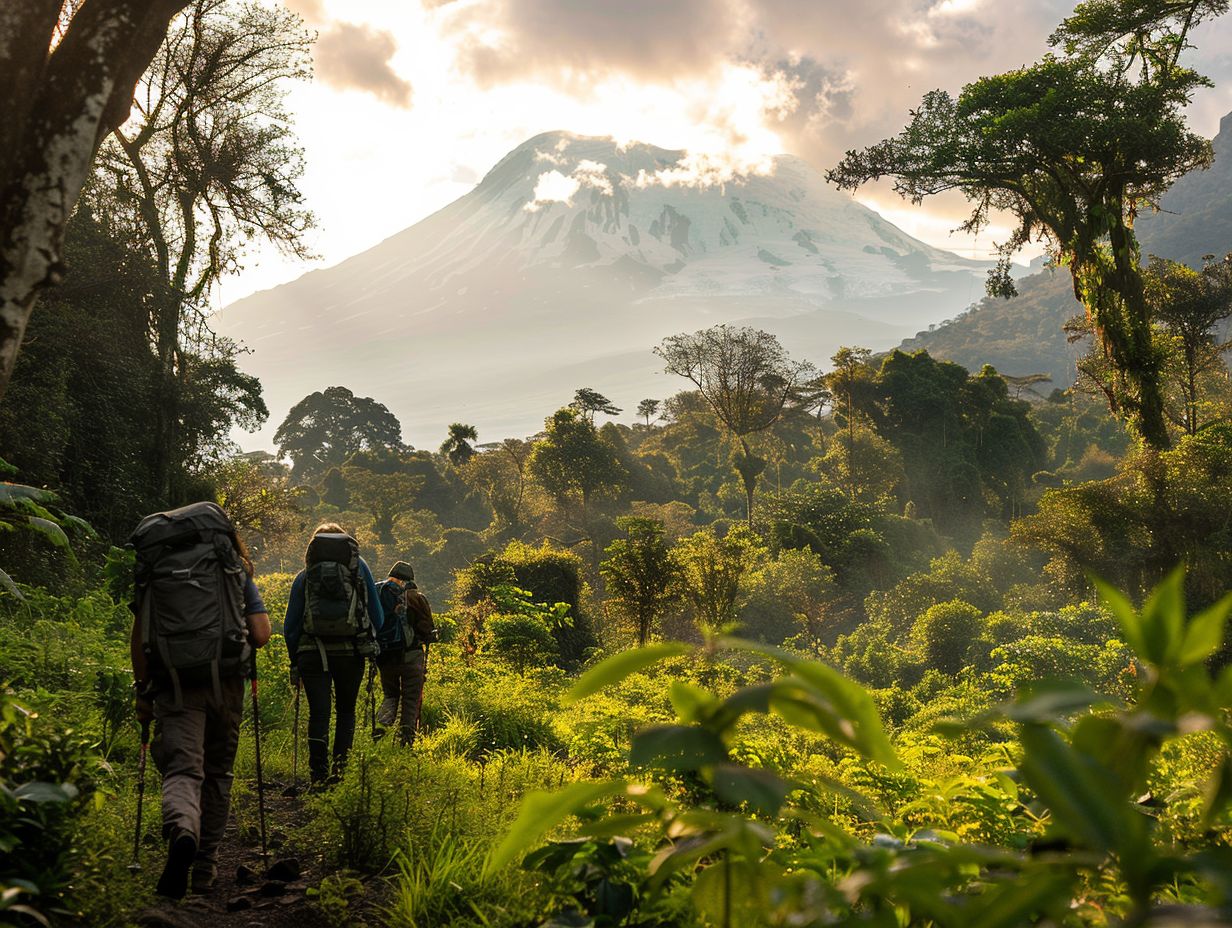
The Marangu Route is one of the seven main routes for climbing Mount Kilimanjaro in Tanzania. It is commonly known as the “Coca-Cola” route due to its availability of amenities such as huts, toilets, and snacks.
How long is the Marangu Route on Kilimanjaro?
The Marangu Route is approximately 64 kilometers (40 miles) long and can take 5-6 days to complete. However, the duration can vary depending on the pace of the trek and individual fitness levels.
Is the Marangu Route on Kilimanjaro suitable for beginners?
Yes, the Marangu Route is considered one of the easiest routes to climb Kilimanjaro and is suitable for beginners. However, it is still a challenging trek and requires proper physical preparation and mental determination.
What is the success rate of reaching the summit on the Marangu Route on Kilimanjaro?
The success rate of reaching the summit via the Marangu Route is approximately 60-70%. This is due to the gradual ascent and well-maintained trail, which allows for better acclimatization.
Are there any wildlife encounters on the Marangu Route on Kilimanjaro?
Although the Marangu Route does not pass through any major game areas, there is still a chance of encountering wildlife such as monkeys, birds, and reptiles. Park rangers accompany all treks to ensure safety.
What is the best time to climb the Marangu Route on Kilimanjaro?
The best time to climb the Marangu Route on Kilimanjaro is during the dry season, from June to October. This provides the most stable weather conditions and better chances of reaching the summit.